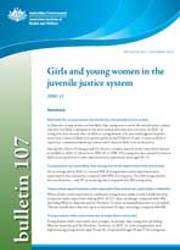Summary
Relatively few young women are involved in the juvenile justice system
In Australia, young women are less likely than young men to enter the juvenile justice system and even less likely to progress to the most serious processes and outcomes. In 2010-11, young men were around twice as likely as young women to be proceeded against by police, more than 3 times as likely to be proven guilty in the Children's Court, 4 times as likely to experience community-based supervision and 5 times as likely to be in detention.
Among the cohorts of young people for whom a complete juvenile justice supervision history is available in 2010-11 (those born 1990-91 to 1992-93), young men were around 4 times as likely as young women to have experienced any supervision when aged 10-17.
Young women are more likely than young men to be supervised in the community
On an average day in 2010-11, around 93% of young women under supervision were supervised in the community, compared with 85% of young men. Very few young women were in detention-only 85 on an average day (compared with 960 young men).
Young women spend less time under supervision than young men, particularly in detention
When all time under supervision is considered, young women spent around 2 weeks less than young men under supervision during 2010-11 (171 days, on average, compared with 186) (excluding Western Australia and the Northern Territory as standard data were not provided). This was mainly due to less time spent in detention (31 days, on average, compared with 68).
Young women under supervision are younger than young men
Young women under supervision were younger, on average, than young men (excluding Western Australia and the Northern Territory). In 2010-11, rates of supervision were highest among young women aged 15 and 16, compared with ages 16 and 17 for young men.
Indigenous young women are over-represented in supervision
In 2010-11, Indigenous young women aged 10-17 were around 16 times as likely as non- Indigenous young women to be under community-based supervision during the year, and
19 times as likely to be in detention. This was slightly higher than the level of Indigenous over-representation among young men (13 and 17 times as likely, respectively).
Rates of young women under supervision have increased
Over the 5-year period to 2010-11, rates of young women aged 10-17 under supervision rose from 0.8 to 1.0 per 1,000 on an average day and from 1.7 to 2.2 per 1,000 during the year, which were greater than the corresponding increases for young men. This was mainly due to increases in the numbers and rates of young women under community-based supervision.



